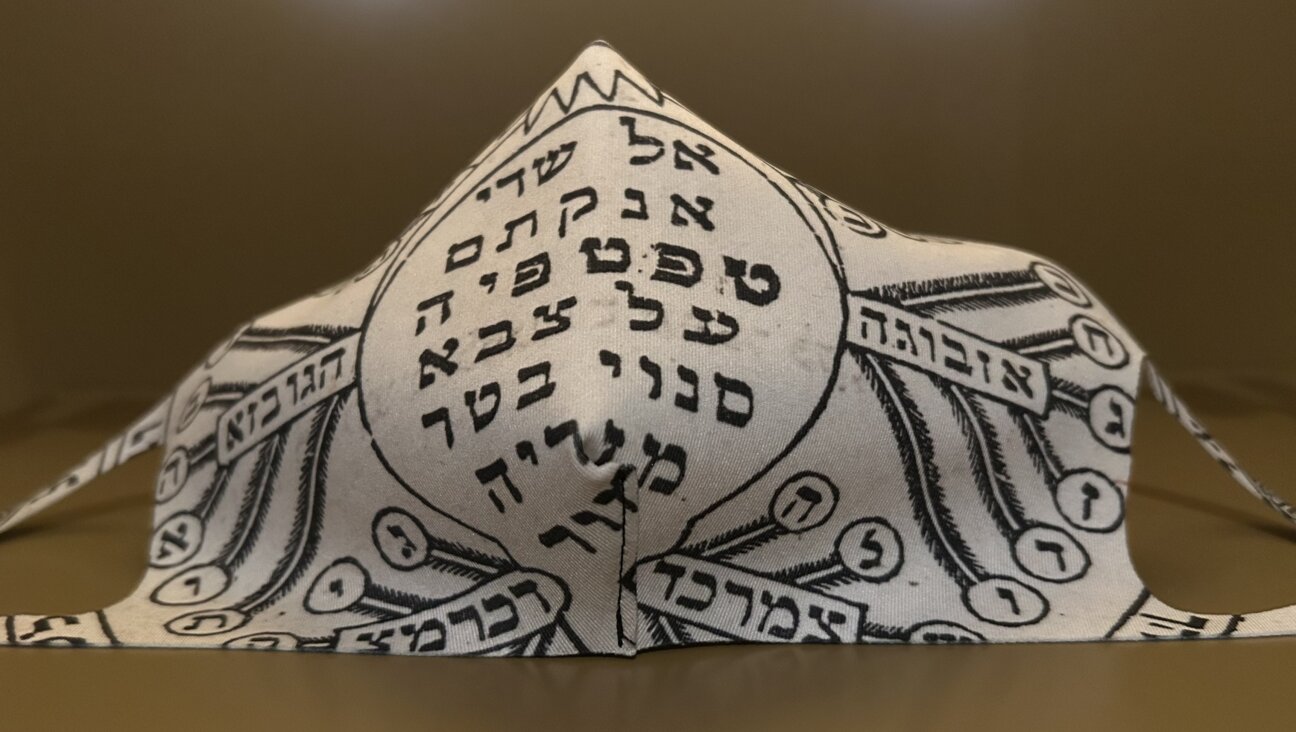Discovering Yom Kippur Tradition And A Beautiful Break-Fast Pastry In Mumbai

Puri, a filled pastry made in Mumbai’s Indian-Jewish community to break the fast after Yom Kippur. Image by Shulie Madnick
This is the second article in a two-part series.
Last year, I made my first visit to Mumbai to walk in my mom’s proverbial footsteps and discover my Indian-Jewish heritage. I spent some time in the kitchen of Sharona Hayeems, a local Jewish caterer, learning her traditional method for making halwa, a sweet Indian custard that the Bene Israel Indian-Jewish community makes especially for Rosh Hashanah.
Watch Sharona Hayeems make a holiday pastry in her Mumbai kitchen:
I wrote about it in “How A Mumbai Cook Prepares For Rosh Hashanah.”
Hayeems and I agreed that I would re-visit her a week later, before Yom Kippur, to watch her make puri, a laminated (layered), deep fried, crescent-shaped sweet pastry filled with sweetened semolina, nuts and cardamon. Puri is a pastry the Bene Israel Indian-Jewish community makes once a year for Yom Kippur’s Break-the-Fast.
During that week, in between the halwa and the puri making, in between Rosh Hashanah and Yom Kippur, I attended services at Magen Hassidim, a beautifully maintained Bene Israel synagogue in Byculla, Mumbai. Magen Hassidim was my mom’s neighborhood synagogue, where she spent her childhood until the age of 20 when she moved to Israel.

Magen Hassidim, a Bene Israel synagogue in Byculla, Mumbai. Image by Shulie Madnick
On Rosh Hashanah, Magen Hassidim’s windows were wide open and the aromas of Indian cooking from the neighboring two-story apartment building were drifting through, intertwining mid-air with the familiar and comforting Avinu Malkeinu hymn sung in Bene Israel’s unique melody. The sound of monsoon rain drops and the kid playing cricket in his living room, just across on the first floor, were the backdrop to somewhat disappointing biddings that ensued for the privilege to open the torah ark and carry the torahs scrolls on Rosh Hashanah. Biddings for the honors, while not exchanging currency on the holidays, are also traditional in some Sephardic and Ashkenazi congregations during both Rosh Hashanah and Yom Kippur.
On Yom Kippur, the biddings were more lucrative and drew in much higher, impressive sums for the honors. On both Rosh Hashanah and Yom Kippur I had a bird’s eye view from the women’s balcony above — women and men sit separately as traditional in Orthodox synagogues — and a lovely teenager sat next to me, as my translator, as I was getting the numbers in Marathi mixed-up.
Later on that day, Tashlich — the ceremony of casting the sins by a body of water — was held at Bhaucha Dhakka (big brother’s dock), Ferry Dock, in the harbor to the east. A gritty fishermen’s dock with clouds of dark fumes spewing from the boats’ smoke stacks, there was a heavy, yet unobtrusive, presence of police and Indian commando, security for the community due to the 2008 terrorist attacks. This was a surreal yet evocative backdrop for casting off the sins, for prayers and blowing the shofar and the matchmaking that happens at Tashlich when the services wrap-up.
Imagine my surprise when my mom told me that Bhaucha Dhakka wasn’t at all where she attended Tashlich while growing up. After my mom called her Indian ladies squad where she lives in Israel, and I did some armchair detective work here in the U.S., we figured out that the Tashlich my mom used to attend was at Mama Haj Ali dock. Indeed it was in “the opposite direction” from Bhaucha Dhakka, as she put it, to the west on the Arabian Sea. It was an hour walk from where she lived inland in Dubash building, if they didn’t catch a rickshaw ride.
My Indian Jewish (Bene Israel) guide, Hanna Shapurkar, of Jewish India Tours, writes in response to my email that “All the synagogues just have one Tashlich prayer at Bhaucha Dhakka ( Ferry Wharf ) now that the numbers dwindled. The Thane community (just outside of Mumbai) organizes special buses for Tashlich. Every year it is a different synagogue sponsoring the event.” During my visit last year, she adds “It (the sponsor) was the Gate of Mercy (Shaar HaRahamim) synagogue. The hazzan was Rafael Gadkar and the shofar was blown by (a person simply known as) Elis.”
After a quick two-night visit to the villages just south of Mumbai where the Bene Israel community first lived, and a long weekend in Cochin (Jew-Town), Kerala, I landed back at Sharona Hayeems doorstep in Dadar, this time to watch her make puri.

Sharona Hayeems filling puri in her Mumbai kitchen. Image by Shulie Madnick
Puri, the little known deep fried, half crescent-shaped pastry filled with roasted semolina in oil, pistachios, almonds, raisins and cardamon, is more widely known in Maharashtra as karanji (filled with sweetened semolina and coconut) and as gujiya (filled with sweetened dried milk) in the north.
Sharona Hayeems was just recovering from a cold and her husband, Bension, was still under the weather, but he carried on his annual puri frying tradition, which I deeply appreciated. Hayeems kneads the flour, semolina, toop (margarine) with milk and chills it overnight in the refrigerator. The milk in the dough, together with the longer-than-usual chilling time, produces an extra supple dough and a super flaky pastry.
The dough is then divided into golf-ball size balls and each ball is rolled out into six-inch rounds by Suneka, Hayeems long-time helper. Suneka then layers seven layers of six-inch rounds while “schmearing” toop and cornstarch roux (called satha in Marathi) in between the layers. It’s similar to the butter in French laminated pastry. The toop and cornstarch mixture is first mixed until fluffy. At this point Hayeems shared an insiders’ tip: If you drop a bit of the fluffy roux into water and it floats, it’s ready to be applied in between the layers.

Puri before being fried. Image by Shulie Madnick
Hayeems then rolled the seven layers into a cylinder, rolled it back and forth gently to elongate the cylinder, sliced along the seam and cut each halved cylinder into small pieces. Each piece was then “smooshed” in between her palms, layers facing down. Suneka then rolled each one, layers facing down, into six-inch rounds. Hayeems then filled each round with roasted semolina in toop with powdered sugar, nuts and cardamon mix, still layers facing the bottom, carefully making sure the filling didn’t touch the edges. She wet the seams with water, folded each into a crescent shape and pressed to seal. Hayeems then cut along the half crescent seam with a pastry wheel for a refined look. Bension climbed carefully onto the counter, sat on the stool set there, and fried each puri for several seconds on each side until golden and the pastry layers bloomed and were visible.
It’s a labor intensive process. Hayeems, Suneka and Bension worked in perfect rhythm and unison.
When Hayeems says toop, she means vegetarian toop, AKA India’s Crisco, similar to margarine. Anjali Koli, a Mumbaiker from the fishermen’s community and a Maharashtrian food expert, further noted “It (AKA India’s Crisco) gives wonderful layers and textures,” as opposed to real ghee or butter.
In Marathi the pastry is called sat padar puri. Sat comes from the word satha (roux), but sat also means seven. Padar are layers. Anjali, who’s family is from Thal, a coastal village south of Mumbai where Bene Israel families lived as well, added that puri is also known as satyachi karanji. Often when the karanji (puri) is made by other Indian communities, on Diwali and other festivals, they aren’t layered. If they are, it is often with only three or four layers. The seven layered puri is unique to the Bene Israel community. Seven (for creation), is a significant number in Judaism.
I wasn’t about to be in Mumbai during the High Holidays and miss Kol Nidrei. I arrived at Magen Hassidim early, as tarps were being laid on the floor. As congregants began to trickle in, they took their shoes off before entering. It was a packed house with women in white saris and white handkerchiefs, lace or shawls covering their heads and men in white button-down shirts wearing kippas.
During the solemn and reflective Kol Nidrei, my heart skipped a beat at the sound of successive booms launched from a nearby roof. At my alarmed look, a lady next to me reassured me that it was only fireworks and a parade wrapping up the nine-day-long Hindu festival, Navratri.
Shulamit Shaulker Madnick (Shulie Madnick) is a freelance food and Travel writer and photographer for The Washington Post, among other publications. She is an Israeli born Bene Israel Indian Jew who lives just outside Washington, D.C., where she is working on her first cookbook. Follow her food blog foodwanderings.com, on Twitter, Facebook and Instagram.
















